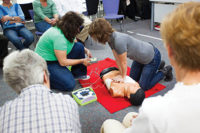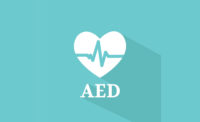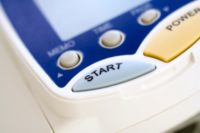Death due to sudden cardiac arrest (SCA) is a big problem. Typically related to heart disease, SCA affects nearly 300,000 Americans each year. As its name suggests, these events occur quickly, and in most cases, without warning. They can occur at any time and in any place.
If one occurs in front of you, you are the only solution. There are only a few minutes between the time SCA occurs and when treatment becomes useless. A bystander has the best and maybe the only chance to help.
How would you deal with a SCA? Simple… you push. Push 911 on your cell phone. Push on the center of the chest. Push hard. Push fast. Push the shock button on the automated external defibrillator. Then, push again on the chest…
Some detail will help.
The heart of the matter
Your heart is a hollow muscle that squeezes down due to a repeating electrical impulse that goes through its tissue. The contraction forces the blood that fills the heart forward into the body. Moving blood picks up the oxygen you breathe in the lungs and continues on to the rest of the body.
This is how we get oxygen, which is required by the body to live, to individual body cells. The tissue most sensitive to a lack of oxygen is brain tissue. It can only survive a few minutes without oxygen. When there is a significant loss of brain tissue, a person cannot survive.
“Sudden” cardiac arrest occurs when the regular electrical impulses in the heart abruptly go haywire and turn the normal squeezing contraction of the heart into a quivering disorder. Technically this quivering is called ventricular fibrillation, and, when it occurs, the flow of blood from the heart stops. This in turn causes the affected person to suddenly lose consciousness and collapse.
The best way to approach this situation is to think about the underlying problem in two parts, mechanical and electrical. The immediate danger is the lack of oxygen to the brain because the regular blood-moving contractions of the heart have been lost.
The way to manage this part of the problem is to somehow find another way to physically move blood through the body. This is accomplished by performing cardiopulmonary resuscitation (CPR) using a combination of external chest compressions and rescue breaths.
Unfortunately, CPR can only deal with the mechanical part of the problem. CPR is not intended to solve the electrical chaos of ventricular fibrillation. It is also limited in its ability to maintain enough blood flow for an extended period of time. Without addressing the electrical part of the problem, CPR will be unable to effectively treat the problem on its own.2
| What we’ve learned |
|
Over time we have seen critical components and principles emerge about what we know today when dealing with SCA:
Most importantly, history teaches you how to use simple concepts in your environment (like having those closest to you knowledgeable in CPR and having a ready-to-use AED nearby) to raise the chance of survival, should you, or someone close to you, go into sudden cardiac arrest. Defibrillation is the use of electricity to “shock” a quivering heart’s electrical activity back into a regular pattern that hopefully can stimulate normal contractions and return spontaneous blood flow. A defibrillator is a device that is designed to deliver defibrillation. |
Without CPR, there is generally not enough time for a defibrillator to work. Without a defibrillator, CPR has a very low chance of success.
Room for improvement
Historically, surviving SCA has been nearly impossible. The current overall national survival rate for SCA in the U.S. is still low, around 10-15 percent. There has been some improvement for society at large, but remarkable improvements have mostly been seen only in local areas that focus on resuscitation fundamentals. Some local AED programs have survival rates as high as 40-50 percent.
Here are some characteristics of SCA treatment:
- It is clear that the high majority of SCA victims are outside of the hospital and away from professional medical help. Bystander participation is recognized as an essential component of effective resuscitation.
- The time to initiate CPR and defibrillation care for a victim of sudden cardiac death is understood as the most influential factor on survival. For every minute a person waits for treatment, there is a 7-10 percent loss for a chance of surviving.
- Hands-free defibrillation provides a much safer approach to defibrillation by reducing the chance of accidental shock to providers. Defibrillation pads are also easy to attach and use.
- The first automatic cardiac resuscitator to be used by a layperson was introduced in 1979. Financial concerns, along with regulatory scrutiny prevented wide acceptance at the time. The device incorporated measuring sensors and microprocessors that determine ventricular fibrillation and automatically deliver a defibrillation shock between an adhesive pad on the chest and a plastic airway with a metal contact against the tongue in the mouth.
- The visual “chain of survival” first introduced in 1987 is still relevant today. Each link (Early Access to 911, Early CPR, and Early Defibrillation) had to be strong to improve the chance for survival. If a link was missing or broken, survival was unlikely. Time, as always, was the most limiting factor for each link. The Chain of Survival is still relevant today with the addition of two more links, early advanced life support, and effective post-resuscitation care in a hospital.
- Since the mid-1990s, widespread acceptance of layperson defibrillation has been the focus. New devices are designed to be effective, safe and easy to use ever since. Usability has been the focus for layperson use of AEDs. Devices continue to improve and become easier to use.
- Around the year 2000, states began to create legislation regarding liability protection for purchasers, medical directors and providers. Today, all states have some type of liability protection for those involved in layperson AED programs.
- Things that contribute to SCA treatment success include well-located AEDs and readily available, trained providers. While these might be lofty goals for the general population at large, they are certainly achievable within a single building, organization or business.
- History has shown much improvement in the ability to treat SCA in the hospital and then in public, but the fact remains that most sudden cardiac arrests occur in the home.
- A growing legal concern is maintaining an AED program in a “ready to respond” state and the need for organizations to think about AEDs as more than just a device on the wall.



